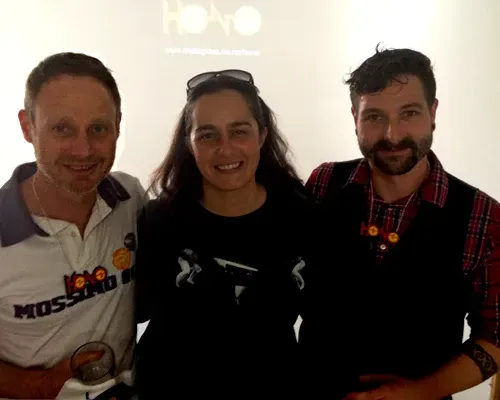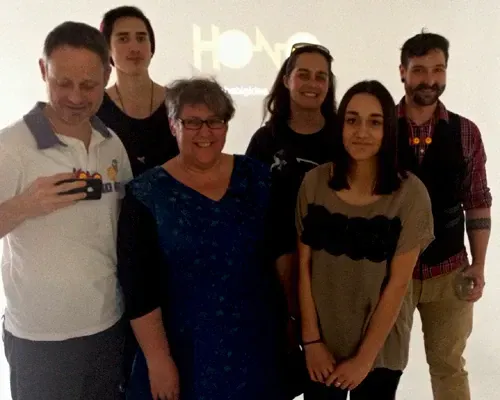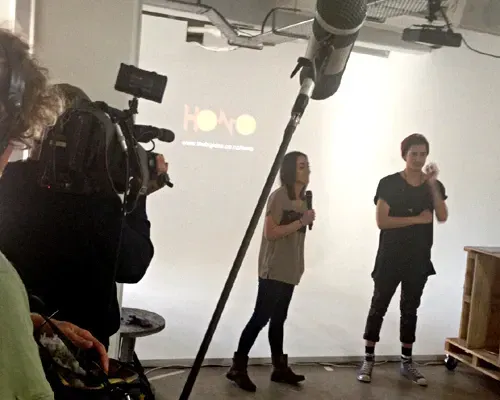A korero on Hono
Written by

Who do you turn to when developing a project to connect young Maori with their communities using digital tools?
With experience in events, television, performing arts and rangatahi development - Shirley Allan had the right background - but most importantly the big ideas, collaborations and energy to pull it all together.
Who do you turn to when developing a project to connect young Maori with their communities using digital tools?
With experience in events, television, performing arts and rangatahi development - Shirley Allan had the right background - but most importantly the big ideas, collaborations and energy to pull it all together.
We had a korero with her about the kaupapa behind Hono, a pilot project by The Big Idea in partnership with the Youth Performance Trust.
Plus she shares some great tips for event management and connecting with rangatahi.
"Our job as adults isn’t to ‘fix’ things for our kids. Our job is to create space for them to find their own way forward. To do this they need to communicate clearly with each other and Hono is my contribution towards that process."
* * *
Tell us a bit about your background
I was born and raised in central Auckland and managed to squeeze in 10 years at the beach (Mt. Maunganui) before coming back up to look at University. I fell into live music events quite quickly after dropping out of Uni and then got caught up in television about 10 years later. All up it must be 20 years now in live production environments – makes me feel old writing it down like that ;)
All along the way I kept finding myself working on ‘brown’, ‘young’ projects. Something about them just kept drawing me in and in mid-2000 I took on some intensive professional development around youth and community development practises. The ‘fit’ was perfect. I suddenly found a way that I could use my skills to connect more meaningfully with my culture in a way that was relevant for me - being a Maori girl, raised Pakeha in the city; this was a major revelation and a huge turning point in my life.
Tell us about the beginnings of Youth Performance Trust, how has it evolved?
In 2003, just before I took on my community development kaupapa, myself and a group of my mates - a.k.a. experienced, performance art professionals - were complaining about a lack of resource designed for young Maori and Pacific people. More specifically we saw need for;
- A wider, pan-Pacific reach
- A contemporary, urban perspective
- An action research/evidence based approach
After a bit of back and forth, we agreed on a charitable trust structure that would use art as the vehicle for engagement. We were deadly serious about binding industry development tightly to the equation and perhaps most importantly, we wanted to explore how our work in the field could contribute to better and more relevant policy for our people.
How did you become involved in Smokefree Pacifica Beats, how has your role changed and the event evolved?
In 1997 I was training in live sound production at MAINZ and bumped into the Smokefreerockquest (SFRQ) competition, the following year I was offered full-time work on the project and my introduction to youth development mahi took place. Over the following 8 years I had the opportunity to work on practically every facet of the event and it was there that I noticed a fledgling component; Smokefree Pacifica Beats (SFPB). At the time it was a prize within the SFRQ comp but by 2000 it had become a stand-alone event and in 2006 I flew to Nelson, made the Rockquest guys shout me some lunch and flew home the following day with the production manual for SFPB.
Since then I am proud to say we have doubled the number of entries, tripled the number of regions and quadrupled the audience numbers attending events. SFPB has also been the catalyst for a spin-off project; The TOIBOX – a youth arts expo that has had successful trials in both Auckland and Whangarei… watch this space whanau!
What combination of people and resources is involved to put it on?
Sheesh, I don’t think you have enough room to fit them all in!! The SFPB team is wide and varied – there are two part-time producers (myself being one) and between us we ensure that EVERY single component of the project is collaborative by nature; it couldn’t exist any other way to be honest.
From the judging team to the MC’s and DJ on stage, to our youth teams running the shows BEHIND the shows, to our industry partners, our funding support, the prize sponsors and how the schools and bands get involved. They all have a huge role to play and each organisation is crucial to the success of the competition every year.
What is Hono – what’s the kaupapa behind it?
Hono is ultimately a youth engagement tool that allows rangatahi (Maori in this first instance) to connect more meaningfully and relevantly with their communities. The name itself is a kupu Maori that can be translated to mean ‘to connect’. In this instance, it was to bind them to The Big Idea, arguably the largest arts network in Aotearoa.
I suppose it it is a storytelling project by nature. Polynesians are an oral culture and so when it came to getting rangatahi Maori and Pacific involved it made a lot of sense to use this approach. Digital media was the medium given to us by The Big Idea and so with tutors Laurent Antonczak and Dan Mace we put together a programme that would teach our rangatahi the skills to tell their own stories using technology they have at their fingertips – mobile phones.
The concept to create short, documentary styled pieces fit very nicely for this pilot effort and it was a no-brainer for me to explore a connection with my SFPB project.
BOOM! Hono was born.
The project is collaborative by nature and has been built with the support of a huge range of experienced and crazy enthusiastic players – not the least of which are our whanau at The Big Idea and our two main tutors; Laurent and Dan.
Tell us about the teams and how they became part of Hono?
For this project we worked with nine rangatahi in total: Riria; a young film-maker from Rotorua, Sarah, Kayla and Jaime; photography students from Pukekohe and Nate, Eru, Hemi, Tipene and Mikaera from Te Kao – these five young men have also just finished working on film project, The Raid Movement. The mix was perfect! As far as first attempts go these talented young artists made the entire process effortless.
How are you turning it into a reality?
Collaboration is the key. The only way forward is together and that has always been a huge kaupapa of mine. Over the years I’ve met many like-minded individuals and immediately I thought of my good friend, Dan… who led me to Laurent. I believe the word for this is ‘serendipity’.
Next up were the physical resources; Skinny came on board in an instant and Te Ara Poutama up at AUT have been long-time partners of mine on many projects – their computer suite is incredible and I knew straight away that was where we needed to be.… which just left the rangatahi! Another very good friend of mine Shirleyanne Brown (great name by the way) is on my speed dial and in less than 24hrs I had the rangatahi confirmed.
To be honest, while the process has taken some time to come to fruition, I believe the wait was worth it – I have been truly humbled by the willingness and generosity of my friends (new and old), colleagues and peers to wrap their resources around our kids like this – based on nothing more than a promise (and a few coffee’s).
What is the final outcome?
Two short documentary clips. One is a ‘behind the scenes’ on SFPB national final weekend and the other will be a ‘behind the scenes’ of the HONO project. We’re excited to be launching on the 11th and it is my VERY strong impression that this concept will have a life FAR beyond this initial attempt.
In fact, I’m so enthusiastic about it I’m starting up a new company based around the concept and will be working hard over summer to explore the bazillion leads that have already come about!
Why is it important for rangatahi to tell their own stories?
The future is theirs. If we don’t teach them how to express their concerns and fears, hopes and dreams, political and social ideologies in ways that are relevant for them – we’re toast. I don’t mean to sound trite, I’m simply stating the truth based on the experiences I’ve had these last two decades.
Our job as adults isn’t to ‘fix’ things for our kids. Our job is to create space for them to find their own way forward. To do this they need to communicate clearly with each other and HONO is my contribution towards that process.
Why are digital tools important?
Ha. What a crazy question but I guess for some people it’s important for them to hear the korero. The bottom line is that by the year 2050, 80% of our workforce will be taken up by jobs that don’t even exist yet – using technologies that haven’t been thought of. You can bet your life on the fact that the bulk of it will exist in a digital format – we need to get to grips with things sooner rather than later.
Everyone has a phone in their pocket, an MP3 player, or an iTouch or something like it. We may as well figure out how to use them properly – get your money’s worth, so to speak.
Hono is about Connections – what are your top tips for connecting with rangatahi?
First of all I just want to underline that ALL they want to do is connect. Just like you and me, they want to be a part of their community, feel like they have a place and are respected for being who they are.
Don’t forget then that YOU’RE the grown up and THEY’RE the young person ;) Subsequently they’re typically shy, nervous, unsure and ultimately have been given a lifetime of ‘respect your elders’ and in many instance being spoken down to. This being the case;
- Take the initiative. Say hi, show an interest in what they’re doing. Speak to them as your equal and I can guarantee that you’ll have your stereotypes of rangatahi turned on their head
- Be authentic. They can smell BS a mile away and will return the favour. Treat them as your peer and not some hoodrat kid you’ve just met.
- Be kind. They’re mirrors and reflect much more clearly that most would care to think about – often if you don’t like what you’re seeing, try changing your attitude, the results are usually instant.
- They’re sharp. Stay on your toes ;) They will surprise and impress you. Every. Single. Time.
What are some of your top tips for event management?
I remember being on a big show as an intern and had just witnessed my producer getting told (very patiently) by his stage manager to get out of the way and let him do his job. My producer immediately turned to me and said that the two golden rules of producing are;
- Build a good team and then
- Get the **** out of their way
I produce all my projects like this to this very day. I suppose though if I was going to add anything to that list it would be;
- Nothing ever works out the way you thought it was going to
- Don’t panic, everything always turns out alright in the end. If it’s not alright? It’s not the end.
What’s your big idea for 2013?
HONO Ltd and a revamp for Smokefree Pacifica Beats… I’d tell you more but I haven’t thought of it yet ;).
* * * The Big Idea 10th Birthday Questions * * *
What does The Big Idea mean to you?
Networking is pivotal to my mahi. TBI offers an opportunity to connect much more deeply and meaningfully than any other community I have come across. I can’t even remember what the arts scene was like in Ak before TBI came along!
What changes have you noticed in Events in the past 10 years?
It’s a real job now! I remember years ago my poor mum trying to explain to her friends what it is that I did for a living ‘so, she organises parties? But what does she do for a job?’.
What are some of the opportunities and challenges for the next decade?
The landscape is changing so quickly and the days of government and agency funding is over. For the creative sector that means the days of ‘empire building’ is over and for resourceful amongst us, it’s nothing but good news. Change isn’t coming whanau, it’s here. You can either stand at the top of the hill and help direct the course or dig your heels in and get swept away by the landslide.
Hono team short doco on the Smokefree Pacifica Beats (SFPB) national final.


